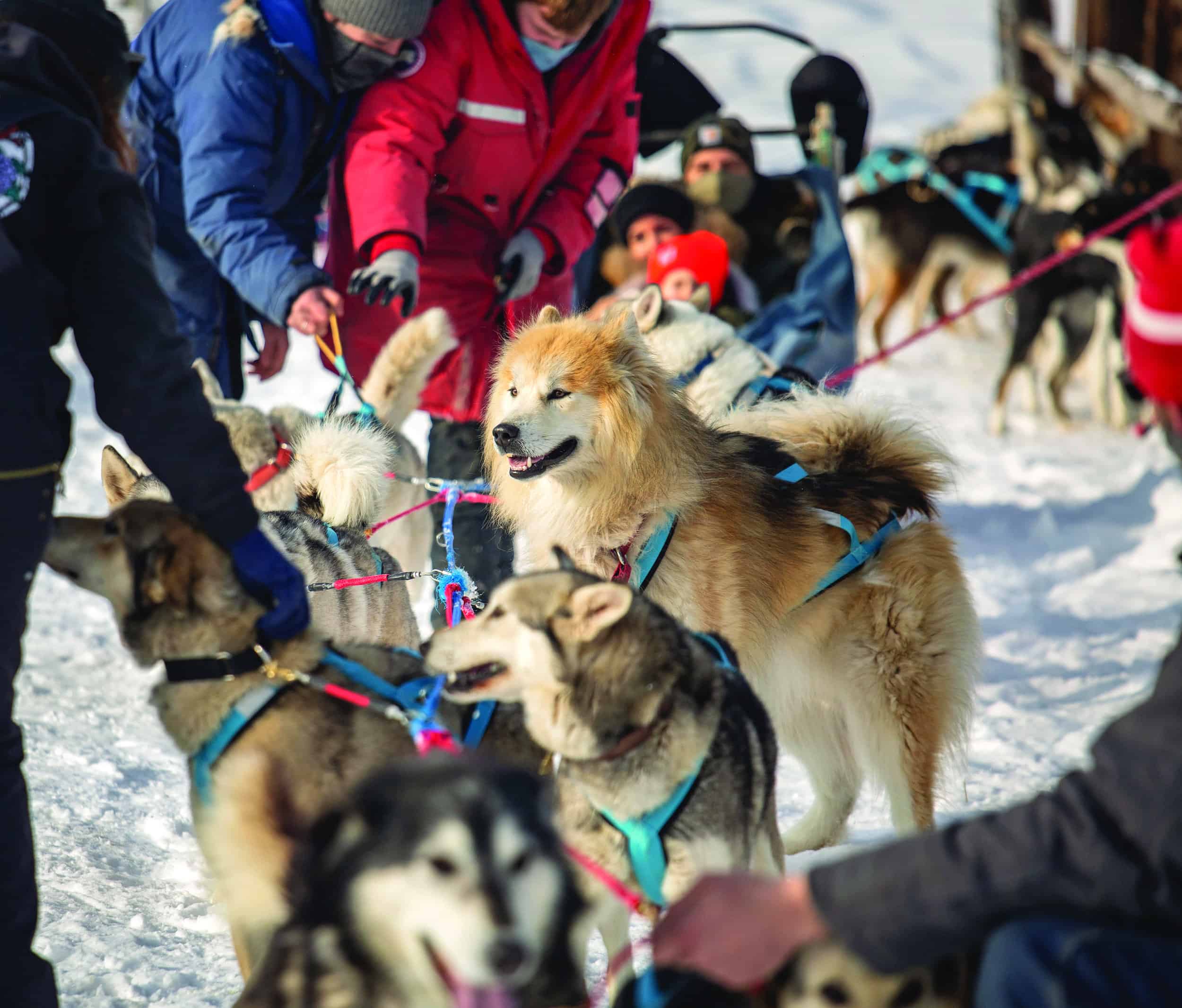Read The
Current Issue
Paw Power
Sit back and enjoy the experience, or try your hand at mushing, at three area dogsledding outfitters.
// By Molly Absolon
The dogs jump and bark, leaping in place and eager to go, only barely held in check by an anchor in the snow. They remind me of a bunch of unruly kids—anxious to let off steam and impatient at having to wait.
“The first 30 seconds seem chaotic. The dogs are so excited,” says Abby Tarver, the owner of Call of the WYld, which offers hour-long dogsled tours at the base of Jackson Hole Mountain Resort for a quick sampling of dogsledding on a trail through open meadows and aspen groves below the Tetons. “But once they get going, the dogs go into work mode. It’s actually very peaceful out on the trail. Children fall asleep on tours all the time.” For now, while they wait to take off, the dogs’ voices electrify the air. Mushers, I learn, call this chorus of barks, whines, and howls “singing,” and I can’t think of a better word to describe this spontaneous outpouring of excitement.
Off the edge of the mayhem, the dogs that aren’t on call for this hour’s tour sit calmly and watch. Tarver takes me around, introducing me to each of them. They all have names and personalities, and she takes time to snuggle with them as she gives me the tour. She’s in her third year of business, and now has 59 dogs in her kennel. Many of the dogs are retired racers. “They still love to run; they just aren’t super competitive,” she says.
The first company in the area to offer dogsledding tours to the public, Frank Teasley’s Jackson Hole Iditarod Sled Dog Tours is located 30 miles to the south. Teasley is a veteran of eight Iditarod Sled Dog Races (his top finish was a sixth place in 1991, but almost more important to him were the Humanitarian Award in 1989 and Most Improved Musher Award in 1991). Closer to home, he’s the co-founder and executive race director of the Pedigree Stage Stop Race, a race that starts in downtown Jackson before taking mushers into the Bridger-Teton, Shoshone, and Caribou-Targhee National Forests. Teasley has worked with dogs since 1981. He considers himself a coach for more than 200 elite four-legged athletes. Some of his canine athletes are racers—the A-team—while others aren’t that interested in competing. The latter take guests for tours along Granite Creek in the Gros Ventre Mountains.
On Togwotee Pass, Continental Divide Dog Sled Adventures, owned by Billy Snodgrass, offers yet another dogsled experience. Like Teasley, Snodgrass has racing experience, including competing in the Iditarod five times. He started dreaming of the Iditarod soon after he began running dogs on his ranch in Dubois, Wyoming, in 1981. Dogs, he discovered, were more reliable than snowmobiles for getting around his snow-covered property. Snodgrass never raced in the Iditarod to win; he loved the great adventure of traveling hundreds of miles through Alaska with his dog teammates.
“We are often told that a dogsledding adventure is the highlight of a winter trip to Jackson Hole,” WYld’s Tarver says. “No matter your age or athletic ability, you will be pulled back in time as the dogs guide your sled through majestic mountain scenery and sparkling snow. These tours provide a perfect balance of exciting thrills, peaceful relaxation, and happy dogs ready to be petted.”
Pulling is in these dogs’ DNA. When you put a harness on them, all they want to do is run.”
— Frank Teasley, Iditarod veteran and founder of Jackson Hole Iditarod Sled Dog Tours
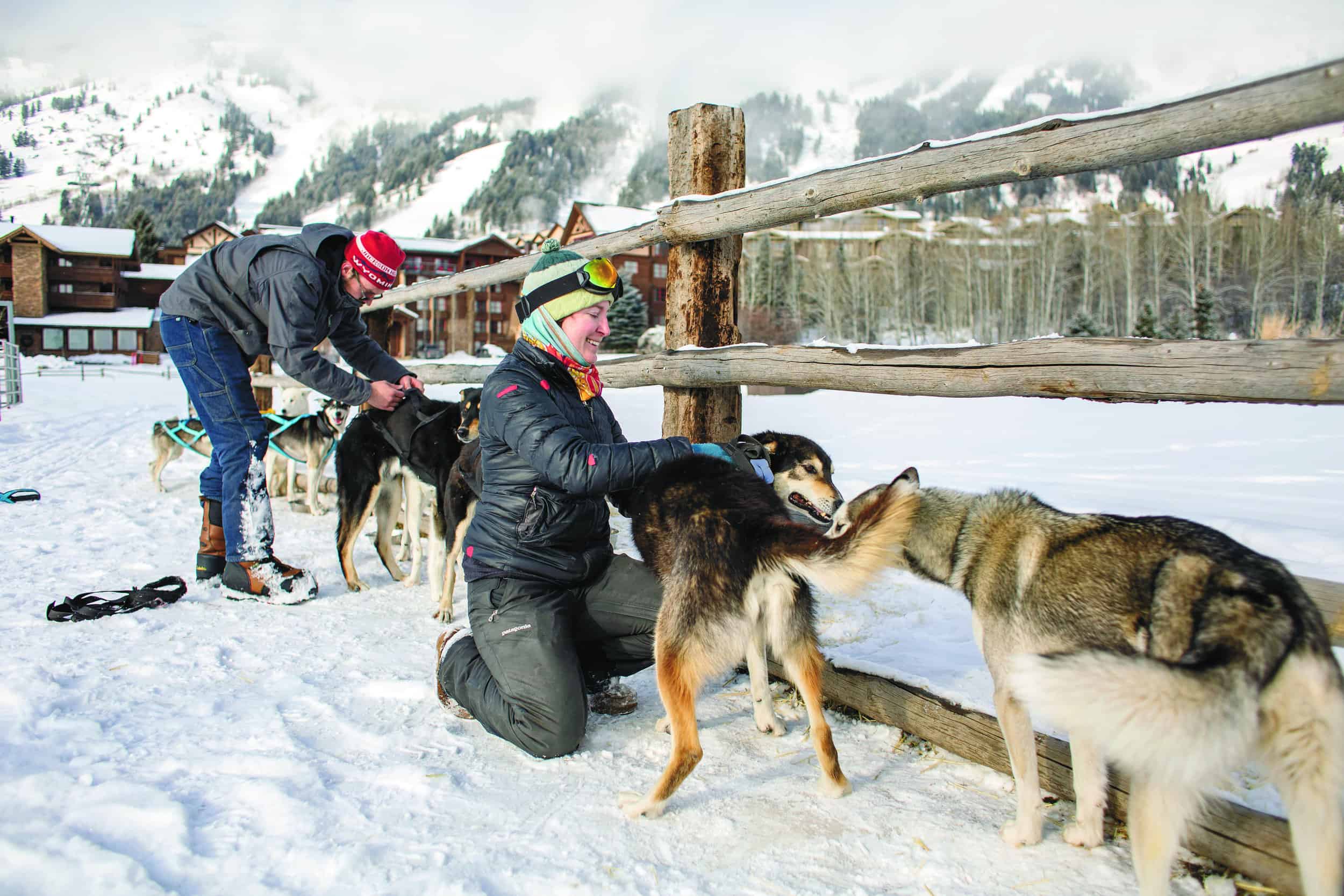
Call of the WYld
Starting on the hour, every hour from 9 a.m. until 3 p.m. with a break at noon for a meet-and-greet with the dogs (this is open to the public), Call of the WYld offers hour-long tours Wednesdays through Mondays between December 15 and March 15 (weather and snow permitting). The tours start on a groomed trail through the woods and then pop into open meadows with—on clear days—a view of the Tetons towering overhead. If trail conditions permit, participants can try standing on the back runners of the sled with their guide. The dogs pull up to 400 pounds, including the guide, so most teams can handle one or two clients per sled. Tours start at $400, $500 on select holiday dates; 307/413-6637, callofthewyld.com
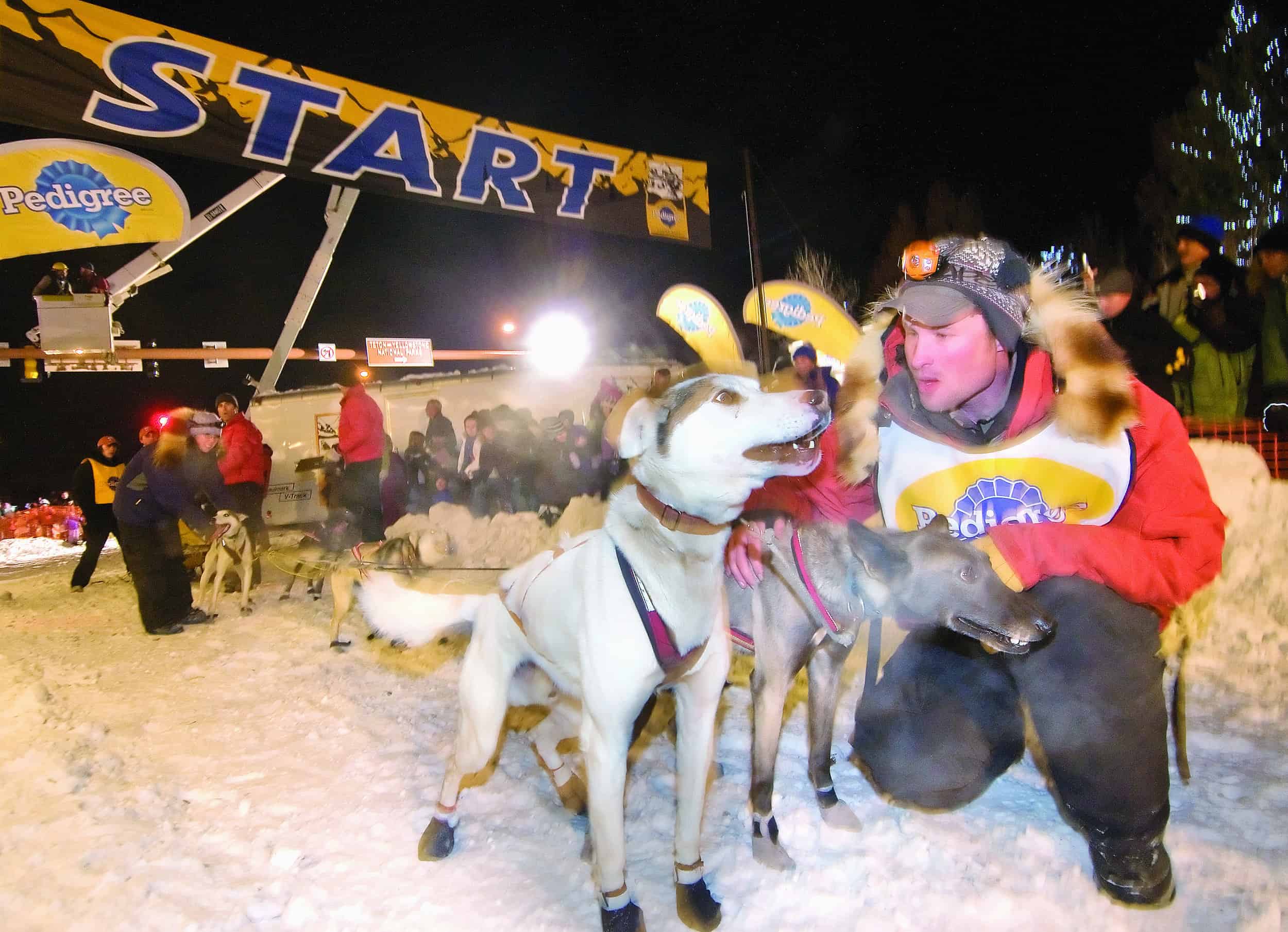
Mushers
Dogsledding is one of the few sports where men and women compete evenly against each other. Anny Malo has won Wyoming’s Pedigree Stage Stop Race for the past four years, and in 2022 the top three finishers in that race were women.
Contrary to popular belief, mushers don’t just stand on the sled rails yelling at their teams to go. They need to be athletic and strong to lean into turns and run up hills. On descents, mushers hold back the sled so it doesn’t overtake their dog team. Mushers need to speak the language of their dogs and to know when to push them and when to hold back.
Both Snodgrass and Teasley were mentored in their careers by some of the great names in dog mushing and, in turn, are now mentoring a new generation of mushers. Tarver, who says she grew up in a cat family, cut her teeth as a dog musher working for Snodgrass. She’d seen a documentary on famous Iditarod musher Lance Mackay and decided she wanted to run dog teams; she showed up in Dubois at the Continental Divide office and said they should give her a job. They did.
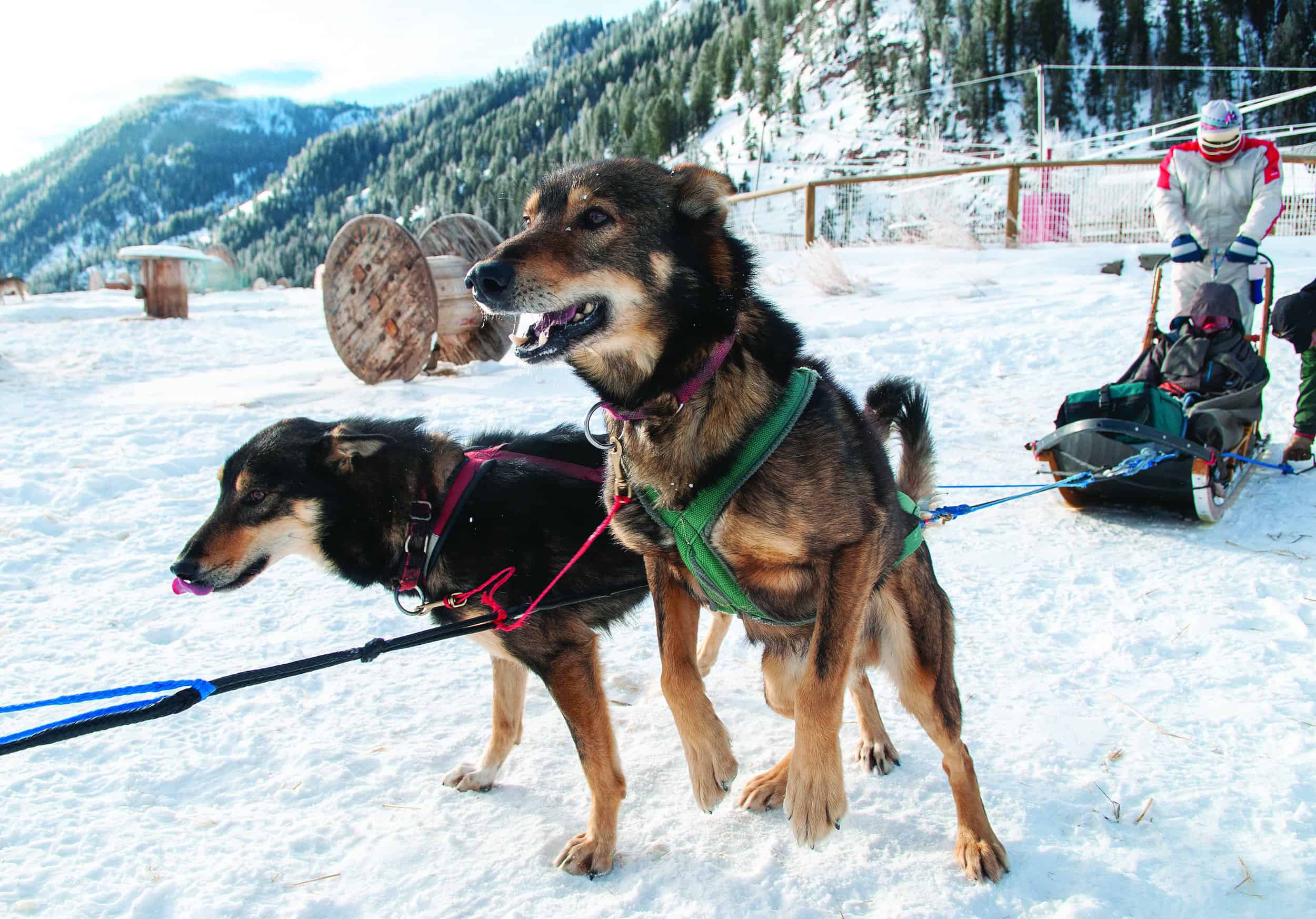
The Dogs
When most of us think of dogsledding, we likely picture Siberian huskies or Alaskan Malamutes. That image comes from Hollywood. Most of today’s sled dogs—at least racing sled dogs—are neither of these breeds. Siberian huskies and Alaskan Malamutes were used to haul loads in the Arctic for hundreds of years. Bred for their strength, endurance, and ability to withstand extreme cold, these dogs are freight animals and can pull heavy loads but aren’t known for their speed. Call of the WYld has a few Siberian huskies in its kennel, but more often, sled dogs these days are Alaskan huskies, which look very little like Siberian huskies or Alaskan Malamutes.
Not recognized as a distinct breed by kennel clubs, Alaskan huskies are essentially mutts. They come in all shapes, sizes, and colorings. Generally midsized, lean, and well-muscled, Alaskan huskies are a product of selective breeding to maximize desirable sled dog traits—speed, endurance, aptitude for pulling, athleticism, intelligence, and tolerance for cold—rather than for specific coloring or conformation like other breeds. On average, Alaskan huskies are about 20 to 26 inches tall, and weigh between 35 and 75 pounds.
Racing teams of Alaskan huskies can travel up to 28 mph. In 2021, Dallas Seavey’s team of dogs ran the 1,000-ish-mile Iditarod Race in a record time of 7 days, 14 hours, 8 minutes, and 57 seconds. (This includes a mandatory 24-hour rest stop and two 8-hour stops.) Iditarod teams average a pace of roughly 8 mph over the length of the course.
Dogsledding has come under fire from animal rights groups in the past, and there were some infamous scandals that colored people’s impression of the sport a few years back. But Tarver, Snodgrass, and Teasley prioritize their dogs’ care and comfort over all other considerations. (Fun fact: Teasley says he goes through 80,000 pounds of dog food a year!)

Continental Divide Dog Sled Adventures
Continental Divide Dog Sled Adventures offers two-hour tours from Togwotee Mountain Lodge, 48 miles north of the town of Jackson just below the highpoint of Togwotee Pass. The tours follow groomed trails that meander through open meadows, pine forests, and under craggy peaks with spectacular views of the Teton Range to the west. Guests can opt to include lunch and transportation from Jackson in their package. Tours start at $310 per guest including lunch and transportation, $250 per guest without; 307/851-6539, dogsledadventures.com

Jackson Hole Iditarod Sled Dog Tours
Frank Teasley and his team of mushers cater tours to clients. If you just want to ride in a warm, cozy sled, great. If you want to try driving a team with your guide, great. Full-day tours include the opportunity to soak in Granite Hot Springs, a historic hot springs pool fed by mineral-rich thermal water. Both half- and full-day tours include a hearty lunch, hot beverages, and homemade cookies. Groups of four can also book an overnight adventure that includes 30–40 miles of trail, a family-style dinner, breakfast, and a bed in a cozy cabin. Half-day tours are $345 per person, full-day tours are $445 per person, overnight tours are $975 per person; 307/733-7388, jhsleddog.com
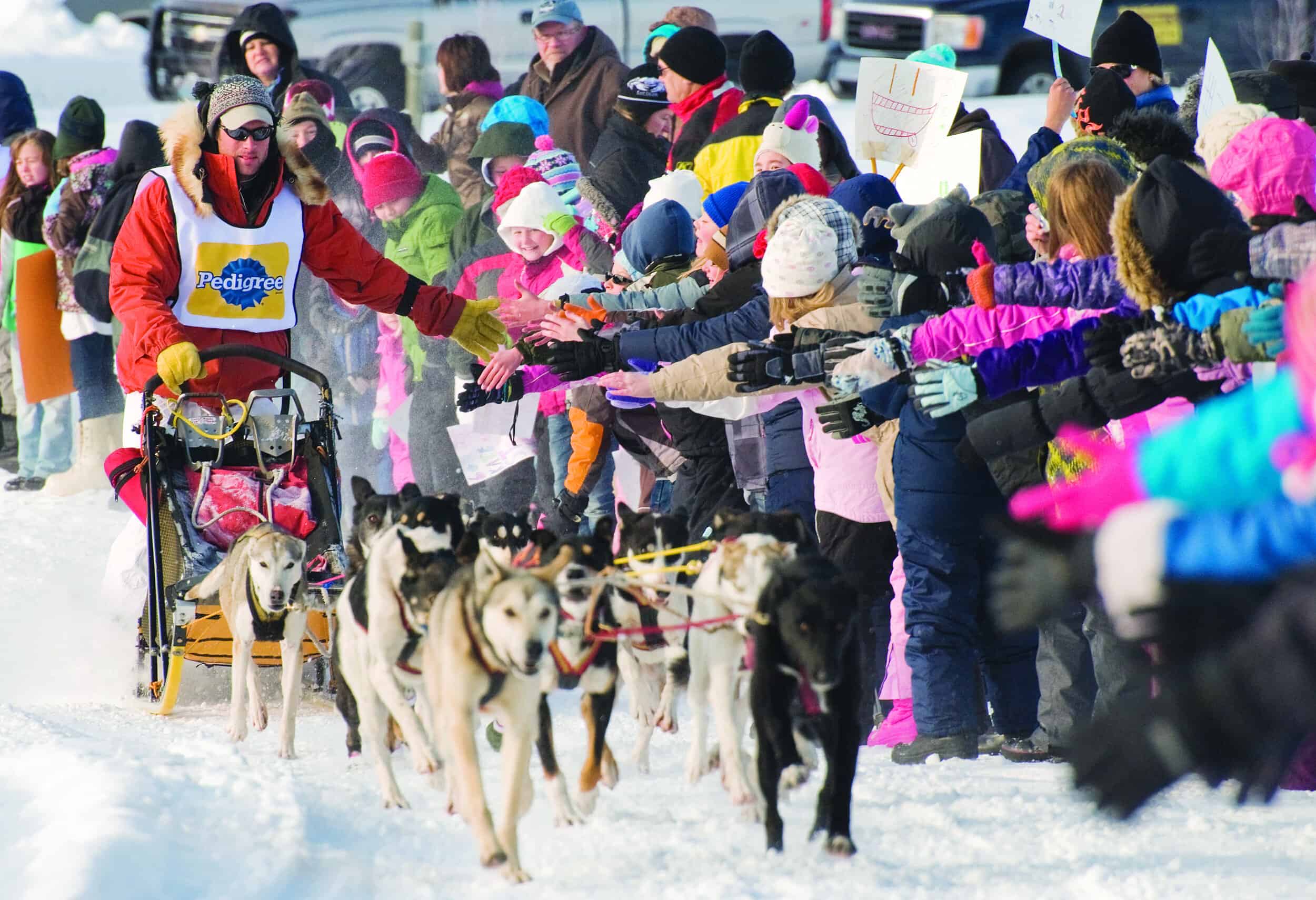
Pedigree Stage Stop
Wyoming’s only sled dog race, the Pedigree Stage Stop Race, was first held in 1996. Founded by Frank Teasley, with the help of Jayne Ottman, the race showcases the state and aims to make sled dog racing more accessible to the public. It follows a Tour de France format, with seven 30- to 35-mile stages in various western-Wyoming/eastern-Idaho communities over the course of 10 days of racing. Jackson has traditionally hosted the race’s start with a ceremonial leg at the Town Square. Communities usually hold banquets for the racers, and spectators are encouraged and welcome at all the stages. The race is known as a fun, family affair, and most mushers love to introduce their dogs to fans. Three hundred and forty-nine teams with a total of 5,496 dogs have raced in the Stage Stop since its founding. The 2023 race will be held January 27 through February 4. JH

